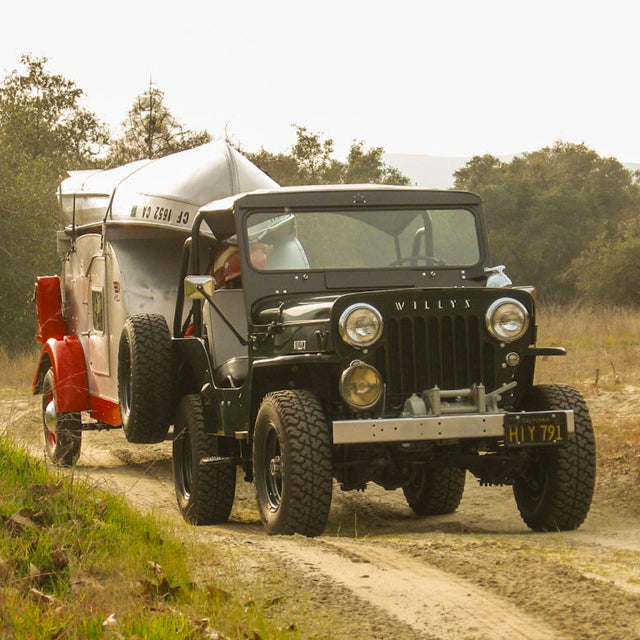Willys Jeeps can go anywhere but they go nowhere quickly. I learned this firsthand as a child growing up in Southern California in the 1950s and '60s with parents who saw nothing unusual about two-day, open-air drives across the American Southwestern deserts in our family's CJ-3B. As far as I knew, it was completely normal for families to arrive at their vacation destination–in our case, the the red rock country of Arizona, Utah, or Colorado–sunburned, windblown, and already exhausted. And, to think, this was our idea of a good time!
Whatever the destination, a trip through the otherworldly landscapes of the American Southwest is an adventure, and my mother often turned philosophical about these hot summer drives through the Mojave Desert or the Great Basin.



“The long hours teach you to be thoughtful, to use your imagination and to enjoy the open spaces,” she once told me. “You can stretch your eyes out here.”
She paused and then added, “besides, honey, when we take the Jeep, I don’t have to talk to your father for the whole day."
In 1949, a few years before I arrived in their lives, Mom and my dad bought a red Willys CJ-2A after learning the hard way (on an ill-advised, National Geographic-inspired trip through roadless backcountry) that their Buick convertible was not built for the rocky desert's rough terrain. Shortly thereafter, Mom and Dad added a Kenskill teardrop trailer, which provided more room for supplies. On their first trip with the new trailer, however, the whole caravan became part of Utah’s Paria River during a flash flood. They managed to extract the outfit and limp it home but the drivetrain–now equal parts sand, water and 90-weight oil–was never quite the same after that. And so, in 1952, Dad went down to Barney Motors in Burbank, Calif., and bought a brand new green CJ-3B.



The CJ-3B proceeded to pull the teardrop trailer and our family through the next forty years of Southwestern wanderings. I made my first trip in the Jeep-teardrop outfit in 1956, when I was but eighteen months old. Over the coming decades, we navigated canyons and forded streams in Capitol Reef in Utah. We camped along the Colorado River in Glen Canyon on what is now the bed of Lake Powell. In 1955, we returned to our Monument Valley campsite one day to find that it had been overrun by Hollywood: Messrs. John Ford and John Wayne had blown into the area and were filmingThe Searchers .
Dad was always eager to see what lay over the next hill but he had little time for paved roads. Armed with topographic maps and whatever folk wisdom he could gather from local guides, he preferred to find the next town by navigating stream beds or desolate plateaus, the more rugged the better. He usually had a fair idea of his current location but he wasn't given to sharing this fact with us, leaving us to believe that he simply had a penchant for getting good and lost several times during each trip. This scared Mom to death, but as a child I didn’t know enough to be frightened. In my young eyes, this was just plain fun.



Back at home, Dad, an inveterate tinkerer, never stopped fine-tuning the family workhorse. In late 1956, tired of second-gear slogs, he installed a 265 cubic inch Chevrolet V8 and along with his friends from Lockheed, where he worked as an engineer, designed and built a new engine/transmission adapter from scratch. Later modifications also included an engine-driven air compressor, eleven-inch brakes, a Warn overdrive, and a whole array of surplus aviation gauges. A variety of racks and mounts for carrying boats, extra fuel, and other sundries, also accumulated over the years.
The family wanderings continued through one last trip with the complete Jeep-trailer combo in the 1980s. The CJ-3B, with Dad at the wheel, remained a frequent site around the streets of Glendale but its age–and that of Dad and Mom–spelled an end to its far-flung adventures. My parents continued to pull the teardrop behind their Oldsmobile wagon well into the early 1990s, and my wife, Pam, and I took them on one last trip with the trailer (this time pulled behind my 1984 Jeep Scrambler) in 1992, but by this time the Jeep and its Kenskill companion were easing into retirement.

Mom and Dad both passed in the early 2000s but thanks to some rejuvenation, the Jeep and trailer are still going strong. Neither truck nor trailer will ever be one-hundred-percent original or receive a frame-off restoration–my parents would have recoiled at the idea. It is, after all, the imperfections on this truck and trailer–what carfolk refer to as patina–that tell the tale of their adventurous life with our family.





























































